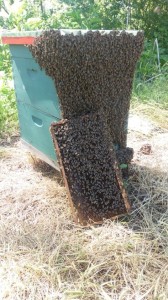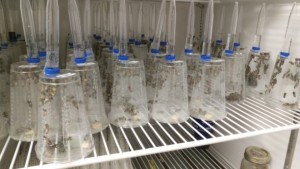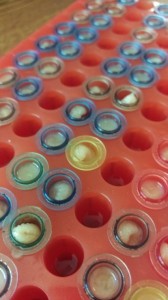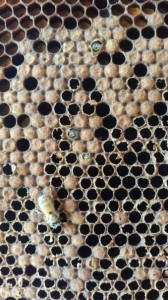This is the next in a series of posts by recipients of the Career Services Summer Funding grant. We’ve asked funding recipients to reflect on their summer experiences and talk about the industries in which they’ve been spending the summer. You can read the entire series here.
This entry is by Danica Fine, COL ’16
 It’s mid-afternoon; the sun looms high in the sky, not yet blocked by the hints of rain clouds that linger in the distance. It’s hot. Almost unbearably hot. And, yet, just a few moments prior, I slipped into a heavy canvas jacket and donned a pair of thick leather gloves.
It’s mid-afternoon; the sun looms high in the sky, not yet blocked by the hints of rain clouds that linger in the distance. It’s hot. Almost unbearably hot. And, yet, just a few moments prior, I slipped into a heavy canvas jacket and donned a pair of thick leather gloves.
But I ignore the heat and the beads of sweat on my forehead, choosing, instead, to focus on the thousands of honey bees situated in the hive in front of me. Inspecting the frame of bees in my hands, I realize it’s not what I want and carefully place it back in the hive. The next frame is better – its cells are filled with eggs and young brood – so I set it aside and move on.
As I reach for the next frame, I notice something peculiar. The usual, gentle roar of the hive is being overtaken by a more intense buzzing from behind me.
I turn to face it, and, immediately, I’m frozen in place by the sight before me. Thousands of bees are pouring from the blue-green hive, zipping back and forth before heading out across the field. I easily recognize that the bees are swarming – their hive became too crowded and a portion of the bees decided to leave along with their queen to start a new hive elsewhere – but before this moment, I had only read or heard second-hand about the process.
Seeing it was an entirely different story.
I stand for a few minutes watching the mesmerizing frenzy unfold until the number of bees exiting the hive begins to dwindle. The hive is calming down, and, satisfied that I have witnessed this brilliant event, I turn to leave. Before I place my first step, I notice something strange: the traffic of bees in front of the hive starts to pick up and the frenzy begins once more. The bees are returning to the hive they just left! Instead of going inside, however, they cluster on the hive’s façade.
I’m baffled by the bees’ actions, unaware that such a thing ever happened.
In that moment, I realized that my years of acquiring knowledge on beekeeping could only prepare me for so much. The rest, of course, would have to come with experience. And seeing as this was my first day on the job, there was plenty of time for that.
——————–
This summer, with the help of a Career Services grant, I was given the opportunity to put my passion for beekeeping to work as I led my own research project under the guidance of Dr. David Tarpy at North Carolina State University (NCSU) in Raleigh, North Carolina.
Like most undergraduates, I was ecstatic simply to have received my summer research offer; I was even more thrilled to know that I would bring my research project down to NCSU’s Apiculture Program to work alongside professors renowned in the world of honey bees. Having come from a family of beekeepers, I saw this research opportunity as a dream come true.
 The purpose of my research was to work toward finding an optimal level of potassium for honey bee consumption. I worked on a small scale, creating tiny colonies of only fifty honey bees (right) which I then fed sugar syrups mixed with varied potassium concentrations. By monitoring how quickly the colonies declined, I could determine which concentrations were best for the bees.
The purpose of my research was to work toward finding an optimal level of potassium for honey bee consumption. I worked on a small scale, creating tiny colonies of only fifty honey bees (right) which I then fed sugar syrups mixed with varied potassium concentrations. By monitoring how quickly the colonies declined, I could determine which concentrations were best for the bees.
Unfortunately, this was more easily said than done.
Although I had an experimental design mapped out, certain issues arose at points during my research. I became well-acquainted with the notion that “Research is one step forward and two steps back.” For the most part, I was less than enthused when things didn’t always work out as planned, but I’m glad that I had my adviser’s encouragement and understanding to back me up as I worked to overcome the various experimental issues.
I may have had a great deal of my own work to focus on, but I didn’t let that stop me from experiencing as much as I could. From day one, I found myself seeing and learning about things that I had never before given a second thought about.
 For example, during my first week at the lab, a fellow researcher asked me to help graft queens. Queen-grafting is a process where young, newly hatched larvae are carefully removed from their cells and placed in a larger, plastic cell along with a high-protein food supplement so that they will develop into queens (left). By doing this, our lab could create as many queens as
For example, during my first week at the lab, a fellow researcher asked me to help graft queens. Queen-grafting is a process where young, newly hatched larvae are carefully removed from their cells and placed in a larger, plastic cell along with a high-protein food supplement so that they will develop into queens (left). By doing this, our lab could create as many queens as  was necessary for our research. I had never had the opportunity to graft queens, so being involved in the process was an amazing chance for me.
was necessary for our research. I had never had the opportunity to graft queens, so being involved in the process was an amazing chance for me.
Even though my day-to-day tasks were often repetitive, I tried my best to stop and appreciate all of the moments I had this summer. On a particularly early morning at the lab, as I collected newly emerged honey bees for use in my experiment, I stopped for a few seconds to watch a few bees chew through the last bit of wax that kept them in their cells (right). It was a sublime moment for me, as it’s always been easy to overlook the tiny intricacies of the hive.
Not all of my experiences dealt directly with my research, however. Egged on by my colleagues, I started leaving my gloves behind when I went to work in the hives. Before coming to the lab, even the thought of working without gloves was terrifying to me. I gave it a chance, though, and found that working so closely with the bees made many of my afternoons that much more rewarding. It was definitely the best decision I made this summer.
Between my talented colleagues, the fantastic moments, and the success of my experiment, I could not have asked for a better research opportunity. I learned so much and accomplished more than I could have ever imagined going into the summer.
I would like to offer my most sincere thanks to Career Services for making this summer possible.

